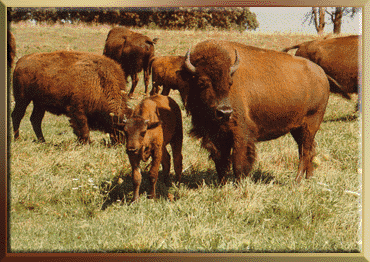Leon M. Lederman Science Education Center
American Bison
What are some of the physical characteristics of Bison?
Horns?
Both bison bulls and cows have horns. The horns on display
are actually a hollow cap which grows over a bone-like core. This
black horny cover is really a growth of modified hair protein.
This cap may be accidentally broken off when the bison digs in
the mud. The cap does not grow back, but the short core hardens
and remains. The cap grows one layer a year beginning at age 4.
Thus the long horn in the case belonged to a 12-year-old animal-8
layers plus 4. While the open end of the horn-cap is hollow, the
pointed end is solid. The sheen on the tip is due to polishing
by rubbing and digging.

Hair?
The sample of bison hair displayed here illustrates the 2 layers
that occur. There is a thin layer of soft fine hair and an outer
layer of course thick hair. The short fine hair is insulation
for the winter. In the spring, the bison shed their hair in large
clumps making them look very shaggy. In the fall, they grow a
new coat.
How Large are the Bison?
Male bison grow larger than female bison. A bull can be 6 feet
high at the shoulders and weigh up to 2000 pounds. A cow is closer
to 4 1/2 feet high at the shoulders and 900 pounds.
What do Bison Eat?
In the wild, bison eat mostly grasses, small plants and twigs of some shrubs. At Fermilab the herd is in a fenced-in area of about 80 acres and cannot move to fresh pastures. Thus, their diet is supplemented with hay, (grown on Fermilab property) and with protein pellets formulated for dairy herds. The Bison have four stomachs, similar to cows. They swallow the grasses whole and then bring up the partially digested food and chew their cud.